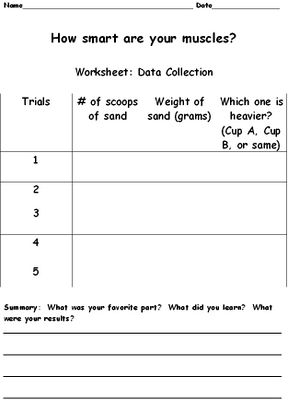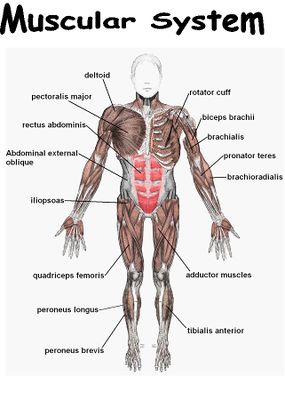How smart are your muscles?
| Instant wiki maker | Making handouts | Editing tips |
Biology In Elementary Schools is a Saint Michael's College student project from a course that ran between 2007 and 2010 and fully described in this book chapter. The student-created resources have been preserved here for posterity. Link under 'toolbox' for printer-friendly versions of the exercises. Click on handouts to print full resolution versions. Please see Wikieducator's disclaimer, our safety statement, and the Creative Commons licensing in English and in legalese.
Student worthiness
This experiment has been tried at least once and has worked well with potential pitfalls. Please see reflections to see changes that need to be made and "must dos" for this experiment.
Primary biological content area covered
Students will:
- demonstrate how their muscles communicate with their brain
- discuss how the muscles communicate with their brain
- make connections between math and science
Materials
Materials required for the teacher's use
- Scale (metric system: grams)
Materials required for each set of partners
- A blindfold
- 2 large cups (16 oz. or greater)
- A marker
- Enough sand, marbles, or beans to fill all sets of partners' cups
- A 60ml scoop
- A 15ml scoop
Handouts
With this handout, students will be given the chance to record measurements, make conclusions, and summarize their findings.
Description of activity
Students will work in teams of two, with one partner blindfolded. The non-blindfolded student will hand their partner two cups with the same amount of sand in each and ask if one weighs more than the other. Assuming the answer is no, s/he will take back the two cups and add a small amount of sand to one of the cups. They will then hand the cups back to their partner and ask if s/he notices a difference. The student will repeat the process until the blindfolded partner notices a difference in weight. Once the blindfolded student notices a difference, the partners will weigh the two cups together. They will record the difference in weight between the two cups. This weight measurement is how much it took for the brain to notice a difference in weight and send that message to the muscles. Students can switch places so that both partners can have the experience.
Lesson plan
1. Begin lesson with a group discussion about muscles. Ask students the following questions...
• Where are your muscles located?
• What do we use muscles for?
• How do we know when to use our muscles?
• How many muscles do we have in our bodies?
2. Next, do a quick model of the experiment and what the students will have to do. This will be brief because the students will need a lot of guidance throughout the experiment anyways.
3. Split up students into small groups (groups of two and one supervisor would be ideal)
4. Once students are split into groups, pass out materials and handouts
5. Now that the preliminaries are done, begin the experiment
Experiment Directions
1. Label one cup 'A' and one cup 'B'
2. Fill each cup half full with sand
3. Blind fold one partner
4. Hand cups to blindfolded partner. Ask "Do these two cups feel of equal weight?" The answer should be "yes"
5. Non-blind folded partner take the cups back and add one scoop of sand to cup 'A'
6. Ask the blind folded partner, "Which cup is heavier or do they weigh the same?"
7. If they answer that one weighs more, are they right? If so, record the result on the data collection worksheet
8. If they answer that both cups weigh the same, take the cups back and add another scoop to cup 'A'
9. Ask questions again
10. Keep adding sand to cup 'A' until blind folded partner notices a difference
11. Once data is collected, students will share their findings and answer the question, "How much extra weight was needed for the muscles to send that message to the brain?"
12. Students will need lots of guidance; therefore, teachers need to visit groups and lead numerous times during the experiment
13. To conclude experiment, students will write on data collection worksheet their thoughts regarding the experiment
14. The last step is for students to CLEAN UP experiment, return materials to box, and hand in worksheets
6. If there is time left over, read "Magic School Bus: Inside the human body". Have kids look for muscles while reading the book.
Potential Pitfalls
When tested for the first time, the following pitfalls occurred:
• The handouts were not adequately matched to what we were asking the students to do. If this particular handout is going to be used, it needs to be modeled and clearly explained.
• It was too complicated for the amount of time we had to complete the assignment.
• The sand was distracting for the students because they wanted to play with it the whole time.
• Further discussion needed to happen in order for the students to understand how this experiment connects to how their muscles work.
• Each group of students seemed to need individual attention and supervision from an adult throughout the experiment.
Math connections
Initial math connections will occur when students are required to weigh the two cups of sand for each trial. Students will also use math when measuring sand to pour into the cups. Once the blindfolded student recognizes a weight differences between the two cups, students will use subtraction to determine the weight difference between the two cups of sand.
Literature connections
• Literature connections will be made when we ask the students questions about their muscles. This will require students to think critically and make text to world connections.
• Literature connections will also be made when students are asked to write and reflect at the end of the experiment.
• After the students complete the activity, we will read "Magic School Bus: Inside the Human Body" by Joanna Cole. This book talks about how the muscles work with and around the digestive system.
Another literature possibility:
Read "Body Works: Songs About Your Bones, Muscles, Heart, and More!" by Jane Schoenberg, Steven Schoenberg, and Cynthia Fisher.
Connections to educational standards
Conducting Experiments S1-2:4 Students demonstrate their ability to CONDUCT EXPERIMENTS by…
- Referring to and following a simple plan for a investigation
- Describing observations using senses rather than feelings (e.g. the snail has a hard shell with wavy, brown lines, rather than the snail is awesome)
- Drawing scientifically: Labeling significant aspects of a scientific drawing or diagram with words provided, and creating a title for a scientific drawing or diagram.
S1-2.8 Students demonstrate their ability to APPLY RESULTS by…
- Developing a reasonable explanation based upon observations
Next steps
After the activity is completed by each child in the group, the instructor can help the group organize the results in comparison to another variable such as the height of each student. The students could then make a simple line graph relating the two variables and make conclusions to determine whether the two variables are related.
Reflections
Heather's ReflectionTeaching our first experiment proved to be a fun and challenging learning experience. I was impressed with the level of excitement demonstrated by the students and their interest in the human body. It was apparent that they had done previous experiments with the muscular system. They knew where your muscles were and what you used your muscles for. This complimented our experiment because then we did not need to explain what the muscles were. The questions that were asked at the beginning of the experiment were helpful because they captured the students' attention to what was going to happen next. In addition, the kids really liked working with the sand. The book we read to them at the end was very beneficial because the kids liked to be read to and our experiment was short and we needed something to fill in the time. This experiment came with many unexpected draw backs. It was difficult to teach this experiment with such a large group. It was hard to give our attention to all the students when there were only three of us. The worksheet that we supplemented was also difficult because we did not have enough time to explain the worksheet and the kids did not have enough time to fill it out. In addition, I think we needed to give more instruction on why this experiment related to the muscular system. I do not think the kids understood the purpose of the experiment. This could be proved during further assessment. To further improve this lesson, there needs to be more time for the kids to observe a model of the experiment and then conduct the experiment by themselves. Following the experiment, there needs to be more time for the kids to reflect on the purpose of the experiment.
Olivia's ReflectionAs our first time teaching in the classroom, I definitely learned a lot about the kinds of things that worked and did not work. It was hard to keep the students' attention in the classroom with another group teaching behind them. Ideally, this is not the best twenty minute experiment to be doing with second and third graders. For this experiment to be successful, teachers would need a significant amount of time to explain, model, and connect the experiment to the muscular system. The students were excited to be playing with the sand, but it was difficult to keep their attention focused on the lesson. In addition, the worksheet was hard for them to follow because there was not enough time to clearly explain and demonstrate how to fill out the worksheet. I also think that it is necessary for us to go through the experiment start to finish, completing the worksheet along with it, before bringing the activity into the classroom. Had we done this, we would have realized that the worksheet needed more explanation. This experiment taught me a lot about teaching science in the classroom and now I feel better prepared to approach designing my next science lesson, avoiding the pitfalls of this experiment.
Lindsay's ReflectionThis was my first time teaching a lesson in the classroom and I probably learned more than the students learned from the experiment. The students showed a great deal of excitement in just about everything they did so this was very beneficial in keeping them interested in our experiment. It was difficult to teach 8-10 students even with three teachers so it was difficult to imagine having to teach about 25 kids on my own. It seemed that our greatest downfall within the experiment was the amount of time we had available to teach our lesson. Although it seemed straightforward to us during the many times we practiced it, we had not taken into consideration the small amount of time we had. The worksheet we included was very time consuming to fill out. As we got to the last few groups we went from filling it out a little to completely ignoring it. It also would have been very beneficial to allow the students more time to reflect on the things they learned and why it was important.
Citations and links
Schoenberg, Jane. My bodyworks songs about your bones, muscles, heart and more! Northampton, Mass: Crocodile, 2005. Print.
"Experiment: Which One's Heavier?" KidsHealth - the Web's most visited site about children's health. Web. 28 Jan. 2010. <http://kidshealth.org/kid/closet/experiments/experiment_heavy.html>.
Cole, Joanna. Magic school bus inside the human body. New York: Scholastic, 1989. Print.


